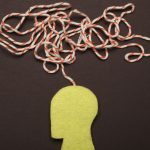9% Of Americans Have An Eating Disorder
According to the National Eating Disorders Association (NEDA), 9% of the US population, or 28.8 million Americans, will have an eating disorder in their lifetime.
Since this number has continued to increase in the last few years, we must raise awareness and provide resources. Let’s support those struggling with eating disorders, promoting healthier relationships with food and body image.
i) Anxiety & Depression
There is a strong, prominent overlap between eating disorders and other mental health conditions, particularly anxiety and depression.
Individuals with eating disorders often experience intense feelings of sadness and worthlessness. In turn, this also precipitates disordered eating behaviors.
* Anxiety, particularly about food, body image, and social situations involving eating, is also common.
This dual burden creates a vicious cycle, where anxiety and depression fuel the eating disorder, aggravating mental distress.
ii) Obsessive Behaviors & Thoughts
Obsessive-compulsive tendencies are prevalent among those with eating disorders.
* This can manifest as an extreme preoccupation with food, calories, and exercise. As seen in conditions like orthorexia nervosa, the obsession with “healthy” eating becomes harmful.
It’s great to eat healthy and exercise, but some individuals may spend excessive amounts of time planning meals, researching food content, or engaging in rigid exercise routines, achieving the “idealized body image.”
iii) Emotional Instability
Mood swings and emotional instability are common, with individuals experiencing rapid shifts in emotions.
This can be due in part to nutritional deficiencies that affect brain function, but it’s also related to the psychological stress of living with an eating disorder.
Feelings of guilt, shame, and disgust with oneself after eating or when perceiving oneself as failing to meet self-imposed dietary standards are frequent.
If you enjoy sweets and desserts, there are numerous options you can try that are healthy, so that you won’t feel bad post-eating.
iv) Social Withdrawal & Isolation
Many individuals with eating disorders withdraw from social activities. Especially when it comes to food, people get anxious about eating in public and feel judged about their eating habits and body.
This isolation can exacerbate feelings of loneliness and depression, further entrenching the disorder.
It’s healthy to get out of the house and go to a restaurant!
v) Distorted Self-Perception
A distorted perception of body image is a hallmark of many eating disorders.
This may include an intense fear of gaining weight, dissatisfaction with one’s body size or shape, and an inability to perceive one’s body accurately.
This distorted self-view can drive unhealthy behaviors aimed at losing weight or altering one’s appearance, regardless of the negative health consequences.
Why Recognizing Symptoms Can Make A Difference
Recognizing these mental and emotional signs are necessary when helping friends and family who are affected by eating disorders. With early intervention, the likelihood of recovery is much higher, as the victim is aware of the support from loved ones and professionals.
Questions, Comments, Concerns?
If you or someone you know is showing signs of an eating disorder, it’s important to seek professional help.
* Remember, eating disorders are not just about food; they’re complex conditions that require a compassionate and holistic approach to treatment.
Share your thoughts and experiences in the comments below, or reach out if you have questions about identifying and supporting someone with an eating disorder.















